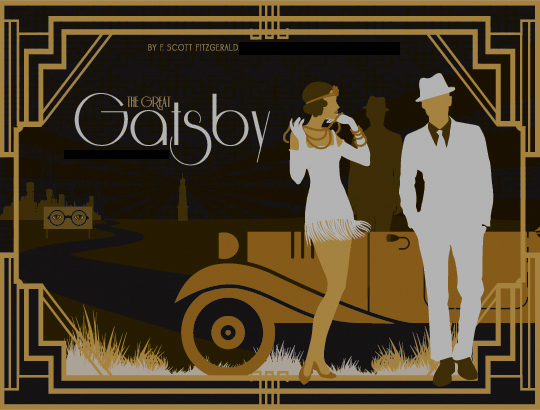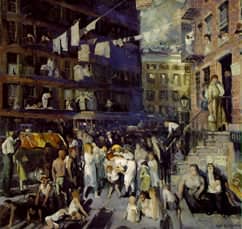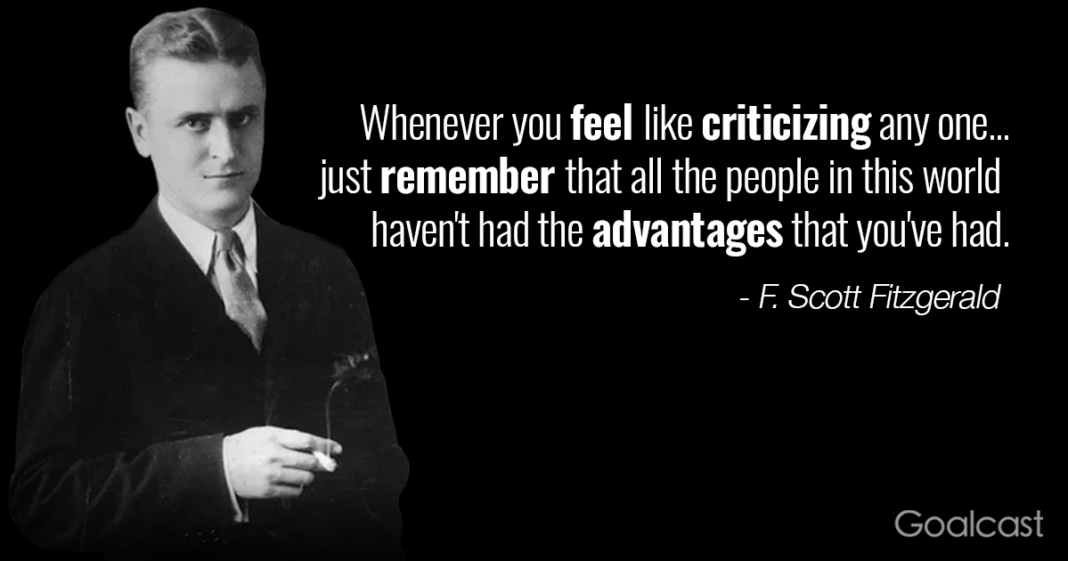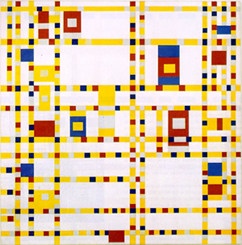JUN 01: Lesson Two - The Great Gatsby
| Site: | MoodleHUB.ca 🍁 |
| Course: | ELA 30-1 RVSO |
| Book: | JUN 01: Lesson Two - The Great Gatsby |
| Printed by: | Guest user |
| Date: | Monday, 10 November 2025, 9:00 AM |
Introduction
Lesson Four - The Great Gatsby
Duration - 10 blocks (10 x 80 min + homework)
"Once one is caught up into the material world not one person in ten thousand finds the time to form literary taste, to examine the validity of philosophic concepts for himself, or to form what, for lack of a better phrase, I might call the wise and tragic sense of life." - FSF

Francis Scott Key Fitzgerald was born on September 24, 1896, and named after his ancestor Francis Scott Key, the author of “The Star-Spangled Banner.” Fitzgerald was raised in St. Paul, Minnesota. Though an intelligent child, he did poorly in school and was sent to a New Jersey boarding school in 1911. Despite being a mediocre student there, he managed to enroll at Princeton in 1913. Academic troubles and apathy plagued him throughout his time at college, and he never graduated, instead enlisting in the army in 1917, as World War I neared its end.
Fitzgerald became a second lieutenant, and was stationed at Camp Sheridan, in Montgomery, Alabama. There he met and fell in love with a wild seventeen-year-old beauty named Zelda Sayre. Zelda finally agreed to marry him, but her overpowering desire for wealth, fun, and leisure led her to delay their wedding until he could prove a success. With the publication of This Side of Paradise in 1920, Fitzgerald became a literary sensation, earning enough money and fame to convince Zelda to marry him.
Many of these events from Fitzgerald’s early life appear in his most famous novel, The Great Gatsby, published in 1925. Like Fitzgerald, Nick Carraway is a thoughtful young man from Minnesota, educated at an Ivy League school (in Nick’s case, Yale), who moves to New York after the war. Also similar to Fitzgerald is Jay Gatsby, a sensitive young man who idolizes wealth and luxury and who falls in love with a beautiful young woman while stationed at a military camp in the South.
Having become a celebrity, Fitzgerald fell into a wild, reckless life-style of parties and decadence, while desperately trying to please Zelda by writing to earn money. Similarly, Gatsby amasses a great deal of wealth at a relatively young age, and devotes himself to acquiring possessions and throwing parties that he believes will enable him to win Daisy’s love. As the giddiness of the Roaring Twenties dissolved into the bleakness of the Great Depression, however, Zelda suffered a nervous breakdown and Fitzgerald battled alcoholism, which hampered his writing. He published Tender Is the Night in 1934, and sold short stories to The Saturday Evening Post to support his lavish lifestyle. In 1937, he left for Hollywood to write screenplays, and in 1940, while working on his novel The Love of the Last Tycoon, died of a heart attack at the age of forty-four.
Fitzgerald was the most famous chronicler of 1920s America, an era that he dubbed “the Jazz Age.” Written in 1925, The Great Gatsby is one of the greatest literary documents of this period, in which the American economy soared, bringing unprecedented levels of prosperity to the nation. Prohibition, the ban on the sale and consumption of alcohol mandated by the Eighteenth Amendment to the Constitution (1919), made millionaires out of bootleggers, and an underground culture of revelry sprang up. Sprawling private parties managed to elude police notice, and “speakeasies”—secret clubs that sold liquor—thrived. The chaos and violence of World War I left America in a state of shock, and the generation that fought the war turned to wild and extravagant living to compensate. The staid conservatism and timeworn values of the previous decade were turned on their ear, as money, opulence, and exuberance became the order of the day.
Like Nick in The Great Gatsby, Fitzgerald found this new lifestyle seductive and exciting, and, like Gatsby, he had always idolized the very rich. Now he found himself in an era in which unrestrained materialism set the tone of society, particularly in the large cities of the East. Even so, like Nick, Fitzgerald saw through the glitter of the Jazz Age to the moral emptiness and hypocrisy beneath, and part of him longed for this absent moral center. In many ways, The Great Gatsby represents Fitzgerald’s attempt to confront his conflicting feelings about the Jazz Age. Like Gatsby, Fitzgerald was driven by his love for a woman who symbolized everything he wanted, even as she led him toward everything he despised. - SparkNotes
Resources 1
RESOURCES
While it is not necessary to browse all the links on this page, there is a great deal of information to be gleaned about the author of The Great Gatsby, F. Scott Fitzgerald, and the Roaring Twenties, the historical context in which the novel is set.
Read the document, The Great Gatsby background, in order to have a basic understanding of various elements crucial to understanding The Great Gatsby.
Ms Nakaska's Great Gatsby Delicious Bookmarks
The Author
- F. Scott Fitzgerald - a biography
- F. Scott Fitzgerald
- F. Scott Fitzgerald - Wikipedia
- F. Scott and Zelda - PBS
- F. Scott Fitzgerald - topics in The Times
- F. Scott Fitzgerald Papers
The Context
- The Jazz Age
- The Jazz Age: Flapper Culture and Style
- Jazz Age Culture: Part I
- Jazz Age Culture: Part II
- Jazz Age Culture: Part III
- Jazz Age 1920s
- The Internet Guide to Jazz Age Slang
- The Roaring Twenties
- The 1920s: A Historical Snapshot of Life
- The Roaring Twenties - all you ever wanted to know
- Roaring Twenties: Social Issues
- Roaring Twenties: Economic History
- The Roaring Twenties: A Biography of America
- Roaring Twenties: Modernism, Consumerism, Hedonism, and Individualism
VIDEO
Lesson
Coming of Age
The term "coming of age" is analytical shorthand for a story (fiction, non-fiction, drama) in which a young character, innocent (at least to some degree) about the ways of the world comes to a more mature understanding of life, relationships and himself. A character in such a story emerges into a new wisdom, a new sensibility, and/or a new maturity. This is what happens to Nick Carraway, the narrator and protagonist of The Great Gatsby. As he himself says in his narration, he came out East (where the novel takes place) with ideas about who he wants to be and wants to relate to the world, particularly the world of finance and fashionable society. As the result of the people, relationships, and situations he encounters, however, he "comes of age", learning that his ideas, in effect his dreams, are in fact illusions and essentially wishful thinking, that the happiness he believed not only possible but inevitable is, in fact, empty and soul destroying. It's important to note that the same sort of realization, the same sort of "coming of age", also happens to antagonist Jay Gatsby, whose dreams of renewing his idealized relationship with one-time beloved Daisy Buchanan are themselves revealed to be empty. It's interesting, however, that while Nick moves on with his life, taking it in a different direction as a result of his realizations (i.e., his "coming of age"), Gatsby never does - he is shot dead by the vengeful George Wilson before he has the chance. His coming of age is, therefore, in a sense, aborted.
Truth versus Lies
Several times throughout the narrative, particularly when it comes to the relationship between Nick and Jordan Baker, the question of honesty comes up. Nick, for example, comments that he is one of the most truly honest people he knows, and seems genuinely uncomfortable when he encounters and/or is forced to confront the falsehoods and misrepresentations of the other characters. On the other side of the coin, Jordan says she's honest, but is ultimately too self-interested to be entirely truthful. Her rumored cheating in sports feels as though it's a true and accurate expression of her character and of how she sees her relationship with the world (i.e., that no matter what it takes, her interests come first). Daisy is, interestingly enough, more truthful (particularly when it comes to her feelings about Gatsby) than is probably good for her, while the self-interested, self-righteous Tom is essentially living a life composed of a tissue of lies, all of which are sustained by money. This leaves Gatsby, whose entire identity is built on at worst a series of lies and manipulations, at best a series of secrets about his personal origins and the origins of his money. But perhaps the most significant component of the package of lies that define Gatsby's identity is the one that he is least consciously aware of - the lie he tells himself that the past (i.e., his past intimacy with Daisy) can be recaptured and reborn. This particular aspect of his character, and indeed of the narrative, is at the core of the third of the work's primary themes.
The Past as Illusion
Nick clearly indicates it, in narration, in the work's final chapter. The most important thing he learned as the result of his experiences, what the reader can see as the key trigger and/or component of his coming of age, and the reason for his return to what he has admitted is the lesser life of the west, is his discovery that the past is an illusion. He further discovers that any attempt to recapture and/or recreate the past in the present, or to define the future in terms of the past, is essentially futile. He learns this through the attitudes and actions of antagonist Jay Gatsby - more accurately, as the result of what happens when Gatsby acts on those attitudes and takes those actions. Gatsby's attempts to bring his cherished, idealized past into the present end ultimately in failure, perhaps even in what might be described as tragedy, in the classic sense of the word, and indicate to Nick that a life lived and defined by the present is a life lived more truly, and more effectively.
In this context, it's interesting to consider the attitudes and actions of Daisy, drawn for a while into the passion and power of Gatsby's illusions, not to mention his lingering love for her. Why does she allow this to happen? Because she has such high regard for herself that any attention that comes her way, particularly of the intensely adoring, or adoringly intense, sort proffered by Gatsby, is not only welcome, but perceived as being essentially right, or just. In other words, while she at first appears to be as drawn to a recreation of the past as Gatsby, thus fueling his dreams and illusions and intentions, she, in fact, has no interest whatsoever in the past except in terms of how it can enliven her present. She, unlike Gatsby, has the past in perspective - a perspective that, as he returns home, Nick probably shares.
The Perversion of The American Dream
Over the years, and particularly in the twentieth century, the so-called American Dream", as a concept, has undergone considerable revision and re-examination. Originally, both phrase and concept originated from, and were defined by, the founding principles of the United States of America - the right to life, liberty, and justice. Over the years, however, the phrase has come, in the minds of both Americans and non-Americans alike, to mean the entitlement to success, happiness, and independence, primarily financial but also social and emotional. The narrative and themes of The Great Gatsby have, in the years since its publication, been generally perceived by critics and commentators not only as manifestations of this evolution but as a condemnation of this apparent "perversion" of the ideals upon which America was founded. In other words, the self-indulgence, self-righteousness, insensitivity, and self-delusion of the main characters (Nick Carraway excepted) have been perceived and regarded as the dark side of that dream, manifestations of which have, it could be and often is argued, become increasingly common in American culture in the near-century since the novel was written and first published. It could be argued, in fact, that another of the work's primary themes, the idea of the past as illusion, is also a manifestation of this theme, Gatsby's loss of Daisy and their original intimacy and love reflecting America's loss of its original values. - bookrags.com
LESSON
You will be reading the novel, The Great Gatsby, in five days, at a rate of approximately 35 pages per day. Use Ms. Nakaska's bookmarks, linked above, to find websites which will provide analysis of the novel, as well as discussion of its various elements.
Consider how the various themes presented above are woven throughout the entire novel. You may want to consider how tightly they are woven along with idealism and truth . . .
Assignment
(100 marks)
Open a new PPT document. Label it as E301U4L2surname
In this document, complete the art assignment as outlined below.
Submit this assignment using the Dropbox for U4L2 Gatsby art
“What is the relationship between great books and great art?”
Imagine that a book publisher is creating a new series of great books that will be presented with companion pieces of great art. You have been hired to produce one of these great books/great art projects for The Great Gatsby.
Phase I: The Great Book
- Select five key scenes in The Great Gatsby. For each scene write a rationale as to why this scene is critical to the book as a whole.
- Analyze each scene you have chosen in the following way:
- Determine what the major focus of the scene is. For example, is it plot development, character, setting, theme, other? Explain.
- Identify dominant sensory images in the scene -- that is, those descriptions that appeal to the senses; make sure to note key visual elements. Why are they important?
- Describe the mood or tone of the scene. Choose two or three vivid adjectives to describe the mood; do no merely say 'sad', but aim for precision in word choice, perhaps 'heart-wrenching' or 'melancholy' or 'bittersweet' or 'wistful' or 'despairing'. Include adjectives that reveal activity, sounds, and smells, also, not merely emotion. Use a thesaurus and dictionary to help you. Explain why this adjective describes the mood.
- Select directly from the text five to ten key words that you feel embody the gist of the scene. Explain each word in at least one sentence.
- Select three or four colours that you feel reflect the overall tone and mood of the scene; the colours need not be mentioned in the text. Explain each colour in at least one sentence.
Phase II: The Great Art
- In very general terms, art can be divided into two major types: representational art, or art that attempts to re-create faithfully the images found in the world around us' and abstract art, or art that attempt to get to the essence of the world around us but does not necessarily attempt to imitate its images.
For example, a representational artist might wish to express a scene of vitality and movement in an urban area. An abstract artist might, on the other hand, aim for the spirit and feeling of vitality through the use use of colour and form. Either work would be very effective in conveying the same idea through different styles. Consider the examples below.
 |
|
| Representational Cliff Dwellers By George Bellows, 1913 Oil on canvas 40 1/4 x 42 1/8 in. Los Angeles County Museum of Art |
Abstract Broadway Boogie Woogie |
- Using the links provided below, browse the various collections of paintings. Using as your guide the analyses (Phase I) you have done on the critical scenes from The Great Gatsby, find one companion piece of great art to complement each scene selected from the novel. Each painting must be an example of great art and not something created specifically for The Great Gatsby!!
- Try to include both representational and abstract art in your final product. Be open-minded; stretch your imagination, but remember to be guided by the gist of each scene.
- Prepare for the publisher a list that includes the title and artist for each work you have chosen to correspond to the key scenes in The Great Gatsby. In a paragraph of at least 250 words for EACH, give the reason for each choice.
- Submit this assignment in PowerPoint format, as though you are presenting to a publisher.
- You MAY want to focus on the role of honesty when an individual experiences tension between optimism and reality." For example, how different would the lives of the various characters had been had honesty been the nature of their motivations?
Conclusion
"'It'll show you how I've gotten to feel about--things. Well, she was less than an hour old and Tom was God knows where. I woke up out of the ether with an utterly abandoned feeling and asked the nurse right away if it was a boy or a girl. She told me it was a girl, and so I turned my head away and wept. 'All right,' I said. 'I'm glad it's a girl. And I hope she'll be a fool--that's the best thing a girl can be in this world, a beautiful little fool.'" Daisy, The Great Gatsby
"But the idea of the 'beautiful fool' also nods to the beauty of those foolish enough to have reckless dreams, unrealistic hopes, untiring aspirations. I'm talking about Gatsby himself, of course, who is a fraud, a criminal, an aristocratic poseur, redeemed only by his uncompromisingly quixotic dream of winning Daisy back. It's Gatsby, not Daisy, who is the novel's truest 'beautiful fool.'" - Joe Fassler, "The Great Gatsby Line That Came From Fitzgerald's Live - and Inspired a Novel"

